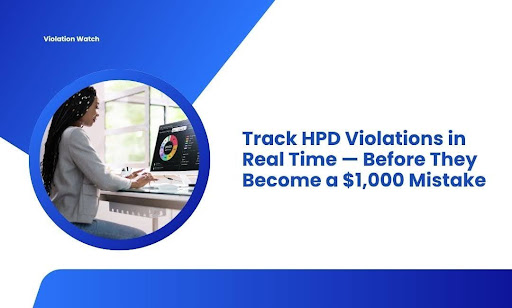That HPD violation you missed last week? It just cost someone $1,000. And it started as a simple $250 fine that could’ve been resolved in minutes.
Every day, NYC properties rack up preventable penalties because violations slip through the cracks. You check one system, miss another. By the time you catch it, what started as a minor issue has snowballed into a costly headache. Keep reading if you want to know exactly how to track every HPD violation before it drains your budget.
Here’s what we’ll cover:
- HPD Online Portal — The official system most people use (and why it’s not enough)
- DOB’s BIS System — A secondary tracking method that catches what HPD misses
- Proactive Monitoring Strategies — Manual methods that actually work
- Alternative Tracking Solutions — Lesser-known approaches that save time
- ViolationWatch — How automated tracking prevents costly surprises
So let’s get started!
Using HPD Online Portal to Track Violations
HPD Online gives you direct access to violation data straight from the source. But here’s what most property professionals miss — the system only shows you what’s already happened. You’re playing catch-up instead of staying ahead.
Getting Started with HPD Online
The portal lives at the official website. Once you’re in, you’ll need your property’s registration number or address. Pro tip? Bookmark your property’s direct link after the first search. You’ll save precious minutes every time you check.
Navigate to the “Violations” section, and you’ll see everything tied to your building. The interface displays violation class, issue date, and current status. But watch out — the system updates can lag by 24-48 hours. What looks clear today might already have new violations pending.
What You Can Actually Track
HPD Online shows you these critical violation types:
- Class A — Non-hazardous conditions (missing smoke detector batteries)
- Class B — Hazardous conditions requiring quick fixes (peeling paint)
- Class C — Immediately hazardous conditions demanding urgent action
Each violation comes with specific deadlines. Miss them and watch those fines multiply. Class C violations, for example, must be corrected within 24 hours. The portal shows deadlines, but it won’t remind you when they’re approaching.
System Limitations You Need to Know
Here’s where HPD Online falls short. The search function only works with exact addresses — no partial matches. Got multiple properties? You’ll need to search each one individually. There’s no dashboard view or consolidated reporting.
The certification process happens entirely within the portal, but the interface feels like 2005. Upload your correction documents one at a time. Submit your certification. Then wait. And wait. The system doesn’t confirm successful submissions immediately, leaving you wondering if everything went through.
Critical gap: HPD Online doesn’t cross-reference with other city agencies. Your building might have related ECB or DOB violations that compound your HPD issues. You’d never know from this portal alone.
Making HPD Online Work for You
Set up a manual tracking system to compensate for the portal’s shortcomings. Create calendar reminders for:
- Weekly violation checks (minimum)
- Certification deadlines minus 48 hours
- Follow-up checks after submitting certifications
Export violation data when possible. The portal allows CSV downloads for some reports. Build your own spreadsheet to track patterns and recurring issues. Yes, it’s extra work. But it beats missing violations.
Some property managers check HPD Online daily. Others rely on weekly sweeps. The right frequency depends on your property’s violation history and current conditions. Buildings with recent Class B or C violations need daily monitoring until resolved.
Small businesses managing properties often struggle with this manual approach, especially when operations expand beyond a single building. The lessons learned from experienced managers? Consistency matters more than perfection when protecting your investment.
The bottom line? HPD Online provides essential data but requires significant manual effort. It’s a starting point, not a complete solution.
Using DOB’s Building Information System (BIS) to Track HPD Violations
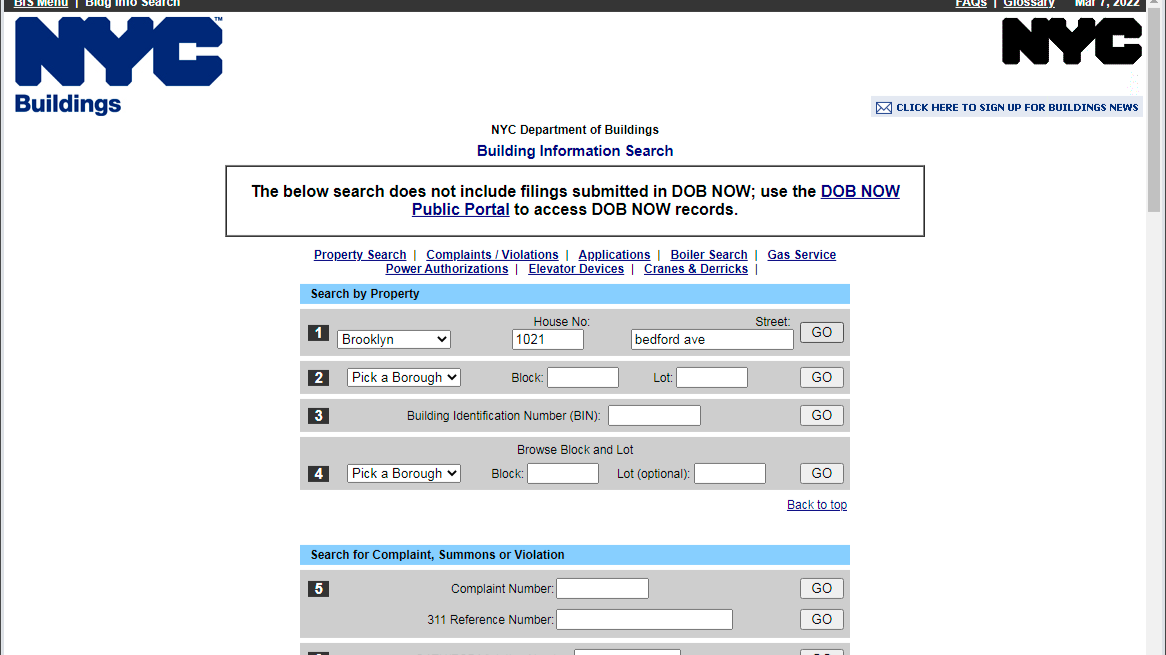
DOB’s BIS catches what HPD Online misses. While technically a Department of Buildings system, BIS aggregates violation data from multiple agencies — including HPD. Smart property managers use both systems to build a complete violation picture.
Accessing BIS for HPD Data
Head to the official site, and you’ll find a more robust search interface. Unlike HPD Online, BIS accepts partial addresses and multiple search parameters. Enter your property’s block and lot numbers for the most accurate results.
The property profile page reveals everything. Scroll past the DOB permits and complaints to find the “Violations-ECB” section. Here’s where HPD violations often appear alongside their ECB counterparts. This cross-agency view changes everything — you’ll spot violation patterns HPD Online doesn’t reveal.
Advanced Search Features That Matter
BIS’s real power lies in its filtering options:
- Date ranges — Pull violations from specific periods
- Violation types — Filter by issuing agency or violation class
- Status filters — Show only open, resolved, or pending violations
- Multi-property searches — Track portfolio violations simultaneously
The system even shows related complaints that might trigger future violations. See multiple noise complaints? An HPD violation might follow. This predictive capability helps you address issues before they become official violations.
Property Owners Reading Between the Lines
BIS displays violations differently from HPD Online. Each entry includes the issuing agency, violation number, and current status. But here’s what to watch for — the “related documents” section. Click through and you’ll find inspection reports, correction notices, and hearing documents that HPD Online doesn’t always show.
Pay special attention to violation descriptions. BIS often provides more detailed explanations than HPD’s portal. These details reveal exactly what inspectors found and what they expect you to fix. Use this information to ensure your corrections address the actual problem, not just symptoms.
Contractors working on your properties can respond faster when you share these detailed BIS reports. The technology behind BIS aggregates data that helps everyone involved — from property managers to repair teams — act more effectively.
Leveraging BIS Data for Better Compliance
Export functions in BIS surpass HPD Online’s capabilities. Download comprehensive violation reports covering all agencies. Import this data into your tracking system for trend analysis. Buildings with recurring violations in specific areas need targeted preventive maintenance.
The “violation history” tab shows resolved violations, too. Study these patterns:
- Which violations repeat annually?
- What triggers seasonal violations?
- How long do certifications typically take to process?
This historical data helps you anticipate and prevent future violations. Budget for recurring issues. Schedule preventive maintenance before typical violation seasons.
Industry professionals in New York know that successful property management means understanding these patterns. Whether you’re managing a single house or multiple buildings across the country, BIS data reveals performance trends that prevent future enforcement actions.
Integration Strategies
Use BIS as your primary research tool, then verify specifics in HPD Online. Here’s an effective workflow:
- Daily BIS checks for new violations across all agencies
- Weekly deep dives into HPD-specific issues via HPD Online
- Monthly trend analysis using the BIS’s historical data
- Quarterly compliance reviews comparing both systems
Remember, BIS updates faster than HPD Online for some violation types. ECB hearings and decisions often appear here first. But for HPD-specific deadlines and certification requirements, you’ll still need HPD Online.
When stakeholders request violation reports, BIS provides the comprehensive view they need. The value of this dual-system approach becomes clear when you catch violations early, avoiding the hell of escalating fines and emergency repairs.
The combination gives you a complete view. Neither system alone provides everything you need. Together, they form a more reliable tracking foundation — though you’re still doing all the heavy lifting manually.
Proactive Monitoring Strategies That Actually Prevent Violations and Enforcement Actions
Manual tracking beats reactive scrambling every time. The most successful property managers don’t wait for violations to appear online — they catch issues before inspectors do. Here’s how to build a monitoring system that works.
Building Your Early Warning System
Start with a violation calendar based on historical patterns. Most HPD violations follow predictable cycles. Heat complaints spike in winter. Lead paint issues surface during turnover seasons. Map your building’s violation history against months and weather patterns.
Create inspection zones within your properties. Divide each building into manageable sections:
- High-risk areas — Basements, boiler rooms, common areas
- Tenant-reported zones — Units with frequent complaints
- Seasonal trouble spots — Roofs before winter, cooling systems pre-summer
- Compliance checkpoints — Fire exits, detector batteries, posted notices
Schedule weekly walks through each zone. Document everything with photos and notes. Small issues caught early never become violations.
Developing Strategic Relationships
Your best violation intel comes from people, not portals. Build connections with these key players:
- Building staff see problems first. Train supers and porters to report issues immediately. Create a simple reporting system — text photos of problems directly to management. Response time matters more than formal procedures.
- Tenants often hesitate to report issues formally. Regular check-ins uncover problems before they escalate to complaints. Send quarterly surveys asking about heating, water pressure, and safety concerns. Make reporting easy and judgment-free.
- Local HPD inspectors follow patterns. Learn their schedules and focus areas. When you spot an inspector in the neighborhood, assume your building will be visited within days. Use this window for rapid corrections.
The human element in violation prevention can’t be overstated. Talking with tenants regularly prevents more violations than any technology solution. Your family-owned buildings or professionally managed properties both benefit from these personal connections.
Documentation Systems That Save You
Paper trails prevent violation disputes. But most documentation systems fail because they’re too complex. Keep it simple:
Set up a shared drive with folders for each property. Inside, create subfolders:
- Monthly inspection photos
- Repair receipts and work orders
- Tenant communications
- Vendor certifications
Use consistent naming: “2024-11-15_Boiler_Inspection_123Main”. Anyone can find what they need in seconds. During violation disputes, quick document access makes the difference between fines and dismissals.
Money lost to violations often stems from poor documentation. Advised by legal experts, the majority of successful violation appeals rely on clear records. These stories from other managers underscore the importance of organized documentation.
Preventive Maintenance Scheduling
Violations often stem from deferred maintenance. Build a schedule that anticipates common issues:
- Monthly tasks: Test smoke/CO detectors, check emergency lighting, inspect common areas, review tenant complaints
- Quarterly tasks: Deep-clean boiler rooms, service HVAC systems, inspect roof drainage, update required postings
- Annual tasks: Lead paint assessments, window guard surveys, comprehensive fire safety inspections, updated registrations
Track completion with a simple spreadsheet. Mark tasks complete only after documentation. This record proves proactive compliance during inspections.
Project managers overseeing multiple properties need systems that scale. Assistance from dedicated staff becomes essential as portfolios grow. The development of these protocols prevents the delays that lead to violations.
Communication Protocols
Quick internal communication prevents violation escalation. Establish clear protocols:
- Issue spotted → Photo sent to management within 1 hour
- Assessment made → Repair scheduled within 24 hours
- Work completed → Documentation uploaded same day
- Follow-up scheduled → Calendar reminder set for verification
WhatsApp groups or Slack channels work better than email for urgent issues. Visual proof speeds decision-making. Response time expectations keep everyone accountable.
Many managers hate the constant vigilance required, but proactive monitoring remains the best defense against violations. Your site visits and systematic approach protect your properties better than any reactive strategy.
The key to proactive monitoring? Consistency beats perfection. A simple system used daily outperforms an elaborate system used sporadically.
Alternative Tracking Solutions Most Managers Miss

Beyond official portals, several lesser-known tools and methods can transform your violation tracking. These approaches fill the gaps left by HPD Online and BIS, giving you earlier warnings and better oversight.
Third-Party Data Aggregators
Several platforms scrape city databases and compile violation data into user-friendly formats. While not official sources, they often update faster and provide better search functionality.
NYC Open Data pulls information from multiple city agencies. Access the violation datasets through the official website. Filter by date ranges, violation types, and geographic areas. Export capabilities exceed both HPD and BIS systems. Build custom reports showing violation trends across entire neighborhoods — useful for portfolio managers.
Property management software with violation modules increasingly includes tracking features. Solutions like AppFolio and Buildium now pull city data automatically. They lack deep NYC-specific features but excel at basic monitoring across multiple properties.
Browser Automation Tools
Tech-savvy managers use browser automation to check violations automatically. Tools like Selenium or simple browser extensions can:
- Log in to HPD Online daily
- Check predetermined property lists
- Screenshot violation pages
- Email alerts for status changes
Setting up takes technical knowledge, but once running, these tools save hours weekly. They catch new violations within hours, not days.
Violation Alert Services
Specialized monitoring services have emerged for NYC property managers. These services check city databases continuously and send immediate alerts. Pricing typically runs per building per month.
What makes these services valuable:
- Real-time notifications — Often faster than checking manually
- Multi-agency coverage — HPD, DOB, ECB in one alert system
- Historical tracking — Violation trends and patterns analysis
- Deadline reminders — Automated alerts before certification due dates
Compare services carefully. Some excel at speed but lack detail. Others provide comprehensive reports but update slowly.
Mobile-First Tracking Methods
Your phone becomes a powerful tracking tool with the right setup. Create mobile bookmarks for quick property searches. Use apps like Evernote or OneNote to maintain violation logs with photos.
Screenshot every violation page when you find it. City websites change, and violations sometimes disappear temporarily. Your screenshot serves as proof and reference. Organize screenshots by property and date for easy retrieval.
Voice memos work surprisingly well for field notes. Spot an issue during property walks? Record a quick description with location details. Transcribe later or use speech-to-text for instant documentation.
Network Intelligence Systems
Join NYC property management groups on LinkedIn and Facebook. Members often share inspector sightings and violation waves. Early warnings from peers help you prepare.
Create Google Alerts for your property addresses plus “violation” or “HPD”. While not comprehensive, these alerts catch news mentions and public records updates you might miss otherwise.
Hybrid Tracking Approaches
The most effective managers combine multiple methods:
- Official portals for authoritative data
- Automated tools for speed
- Alert services for convenience
- Network intelligence for context
Layer these approaches based on your portfolio size and risk tolerance. Single-property owners might use official portals plus one alert service. Large portfolios benefit from full automation plus dedicated monitoring services.
Remember, alternative solutions supplement but don’t replace official sources. Always verify critical information through HPD Online or BIS before taking action.
Track HPD Violations Using ViolationWatch for Complete Automation
Manual tracking eats hours from your week. Between checking multiple portals, setting reminders, and organizing documents, you’re spending more time tracking violations than fixing them. ViolationWatch changes this equation entirely.
How ViolationWatch Streamlines HPD Violation Tracking
The platform follows a simple step-by-step process that transforms violation management.
- First, you sign up and add your properties to the system. This one-time setup takes minutes, not hours.
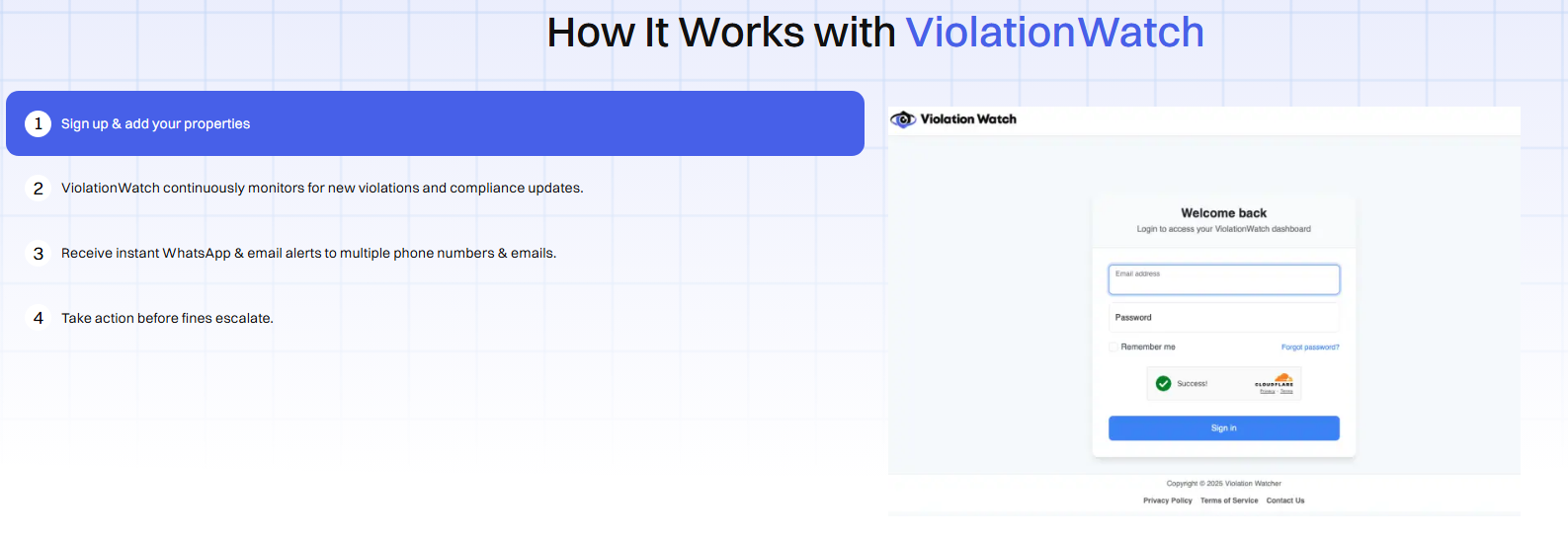
- Next, ViolationWatch continuously monitors for new violations and compliance updates. The system checks HPD databases along with nine other NYC agencies every few hours. No more daily portal logins or missed violations during busy periods.

- When violations appear, you receive instant WhatsApp and email alerts to multiple team members. Everyone stays informed simultaneously. The notification includes violation details, deadlines, and direct links to your dashboard.
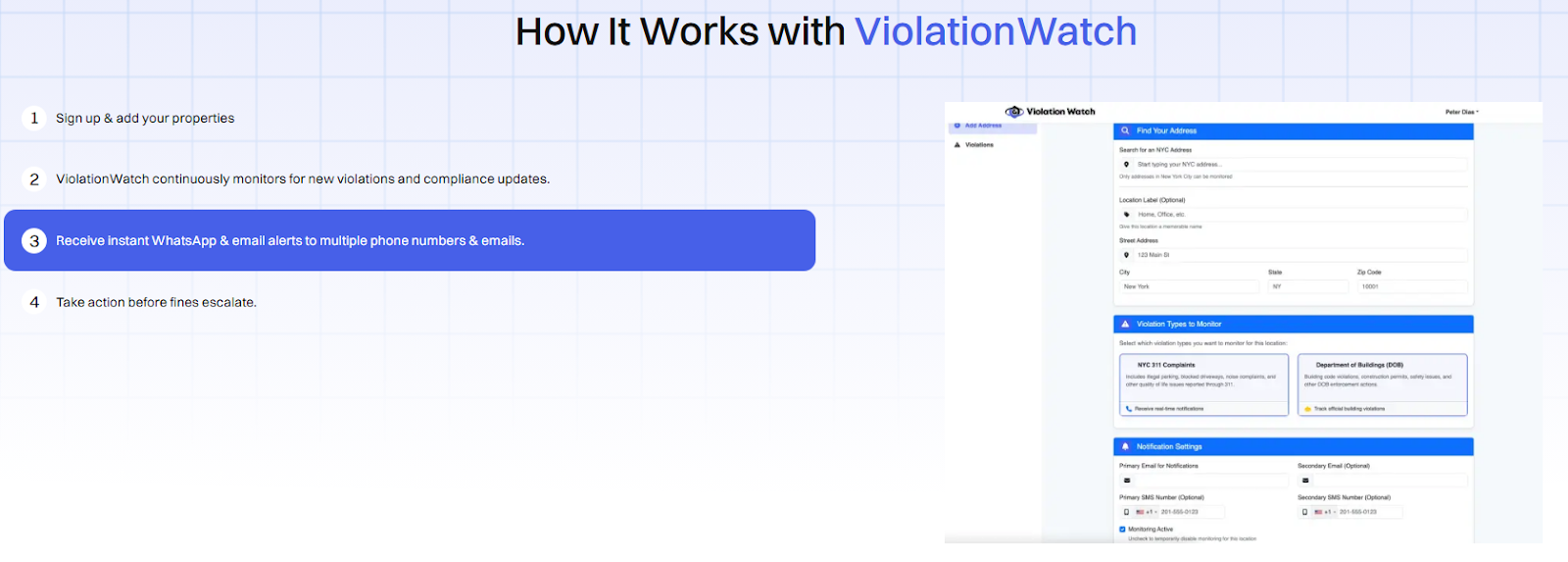
- Finally, you take action before fines escalate. With all information centralized and deadlines clearly displayed, your team addresses issues promptly. The platform tracks your progress and reminds you of upcoming certification dates.
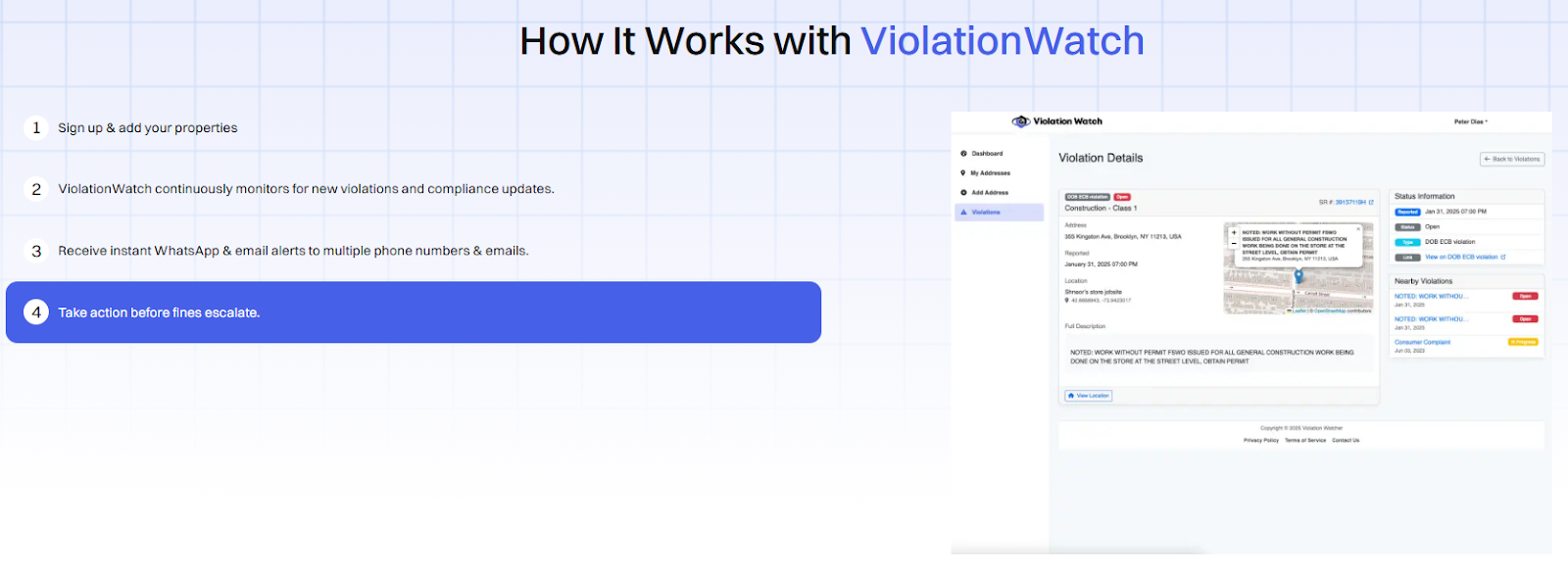
Key Features That Make a Difference
Understanding how ViolationWatch works reveals why property managers save hours weekly. The platform delivers specific features that address your biggest tracking challenges:
- Color-Coded Dashboard — Red alerts for urgent violations, yellow for upcoming deadlines, green for resolved issues
- Smart Document Storage — Upload photos, receipts, and certifications directly to each violation
- Multi-Property Views — Manage entire portfolios from one screen without switching accounts
- Advanced Filtering — Sort by property, agency, deadline, or violation type instantly
- Team Notifications — Alerts go to multiple emails and phone numbers simultaneously
The system eliminates manual data entry completely. Violation details, deadlines, and compliance requirements update automatically as city databases change.
Making the Switch Makes Sense
The benefits are clear when you compare automated tracking to manual methods. ViolationWatch delivers measurable improvements in violation management:
- Faster Response Times — Address violations within hours, not days
- Reduced Fine Risk — Never miss certification deadlines or court dates
- Complete Compliance History — Access past violations and resolutions instantly
- Expert Guidance — Get help from compliance professionals when needed
Flexible pricing options make automation accessible for any portfolio size. The pricing structure includes:
- Free Trial — $0/month with no credit card required
- Per Address Plan — $9.99 per address monthly
- Custom Enterprise Solutions — Tailored pricing for large portfolios
Test the system risk-free before committing. Most users see immediate time savings from day one.
Stop Tracking Violations Like It’s 2005
You’ve learned five different ways to track HPD violations, from official portals to automation tools. Each method has its place, but only one saves you from the endless portal-checking cycle. Here’s what matters most:
- HPD Online and BIS work but require daily manual checks across multiple systems
- Proactive monitoring catches issues early through consistent property walks and documentation
- Alternative tracking tools fill gaps but still need constant oversight and verification
- Full automation monitors continuously, alerts instantly, and organizes everything in one dashboard
Manual tracking worked when you had one property. Now you need something that scales with your portfolio. Start your free trial and see how automated violation tracking transforms your compliance workflow.

